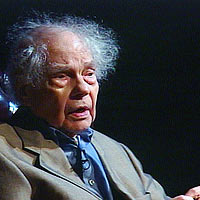
Editor’s note: Merce Cunningham passed away on July 26, 2009.
One of the 20th century’s most original dance-makers, Merce Cunningham has influenced a generation of choreographers with his abstract and complex methods of movement analysis and cerebral yet aesthetic creations. In fact, Cunningham’s love of intellectual engagement and his academic background make his company a natural favorite at colleges and universities. Spark follows the Merce Cunningham Dance Company to Stanford University as he and his dancers take on “Encounter: Merce.”
“Encounter: Merce” was an unusual campuswide interdisciplinary project that took place in March 2005. The event put Cunningham’s decades-long career in context, with exhibits, films, workshops and panel discussions presented not only by the dance division and arts presenter Stanford Lively Arts, but also by the music and visual arts departments and the Stanford School of Medicine.
During the early 1940s, Cunningham performed with the legendary Martha Graham, originating roles in works like “Appalachian Spring” and “El Penitente.” Though he was heavily influenced by the Graham technique of dancing, Cunningham’s own choreography broke away from her mythological, story-based ballets and moved toward a more conceptual approach to dance. By 1953, when his own small troupe of dancers made its formal debut as the Merce Cunningham Dance Company at North Carolina’s progressive Black Mountain College, Cunningham was already crafting works that pioneered new ways of thinking about the mechanics of movement.
Like Cunningham himself, his dancers are often ballet-trained, but their extraordinary physical awareness allows them to tune in to movement with an analytical sensitivity. Cunningham’s love of technology has also led him to experiment with an imaging software program called DanceForms, which he used to create many of his works, but which also allows for an anatomical study of the possible motion of the body.
Over the years, Cunningham has collaborated with a wide range of artists, from Robert Rauschenberg to Radiohead, although he has had no more famous association than with composer John Cage, whom he first met in the early 1940s. With Cage, Cunningham experimented boldly with techniques of dance construction in which the structure relies upon chance procedures, or aleatorics. In his 2003 “Split Sides,” for example, the specific combination of music, set design and even choreographic sequence is determined by a roll of the dice at the start of the show. For Cunningham, these chance encounters of music, dance and art impart a serendipity to his pieces, in his words, allowing “distinct elements to come together to make something that was not possible otherwise.”
Resources
- Array
- Array
- Array

